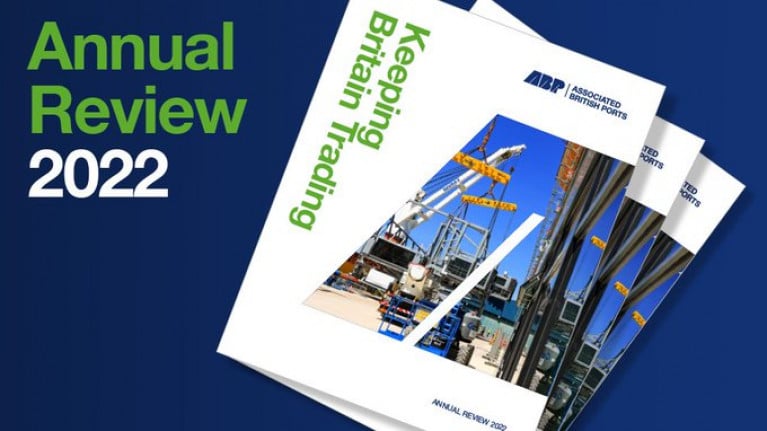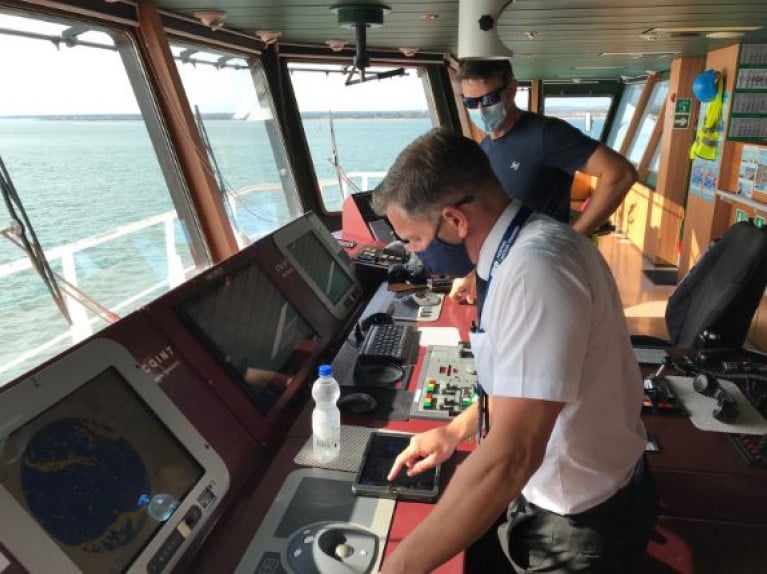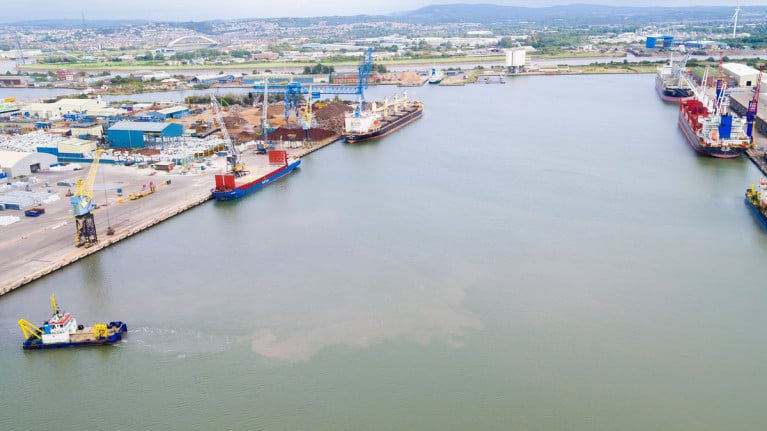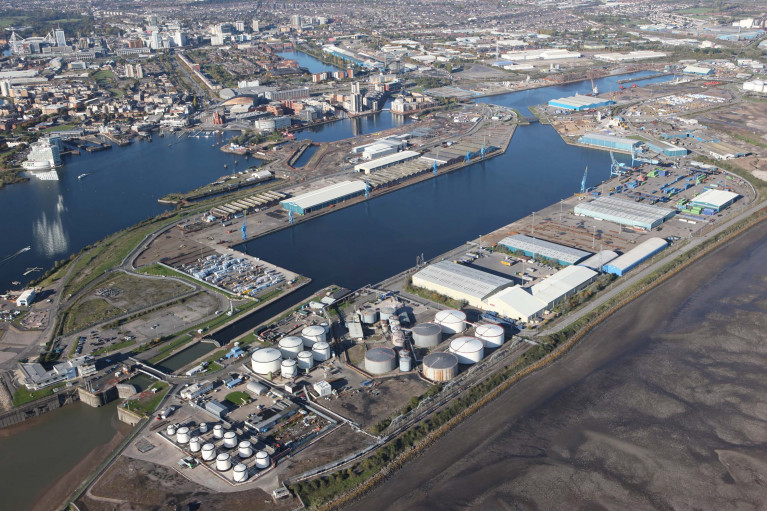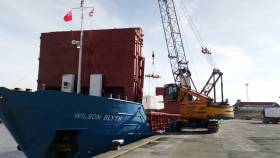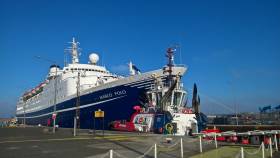Displaying items by tag: ABP
The leading ports group in the UK, Associated British Ports (ABP) has published its Annual Review 2022 (download), reflecting on its success in “Keeping Britain Trading”, and its many achievements in the past year as it supported its customers throughout a challenging period.
ABP’s Annual Review 2022 demonstrates how ABP is investing to build more resilient, sustainable supply chains, embracing innovative new equipment and technology, building infrastructure, and enabling trade and economic growth in regions and coastal communities around the country.
The year saw several industry firsts in the field of technology and sustainability, including the arrival of two fully ‘mains powered’ electric cranes at Ipswich, and the world’s largest hydraulic crane at Immingham. ABP also became the first organisation in the UK to invest in innovative wearable safety devices and the first UK port operator to provide a new range of Personal Protective Equipment (PPE) workwear with an SA8000 certification of social responsibility.
ABP’s Chief Executive Officer, Henrik L. Pedersen said: “Our port operations continue to lead the industry thanks to our people and our continuous investments, such as upgrading our Humber container terminals, building new warehouses for our customers, and acquiring new cranes and port equipment, powered by biofuel, electricity, and a significant amount of solar power.
“In 2021, we invested over £150 million in our ports, as we continue to embrace technological advances, such as launching the first private 5G network of any UK mainland port and being the first to install commercial shore power connectivity in the UK at our Port of Southampton.”
Maritime Minister Robert Courts said: “New technology and sustainability are key to maintaining the UK’s strong position in international trade, and it’s great to see Associated British Ports take these all-important steps to secure our maritime sector's green legacy.
“We’ve faced unprecedented challenges over the last few years and this annual review shows just how innovative the UK’s maritime sector is.
“As we move towards net-zero emissions, I hope to see more industry leaders follow in their footsteps and strive towards a greener future.”
To date, ABP has invested over £60 million across its ports in electric/hybrid equipment and on-site solar arrays and wind turbines, which has contributed to a reduction of over 35% carbon emissions in its port operations. ABP is also at the heart of the renewable energy sector, supporting the continued growth of the Offshore Wind industry and the development deployment of new technologies such as hydrogen and carbon, capture and storage.
ABP’s ports are primed and ready for the UK’s transition to alternative and low carbon energy production and following the success of Green Port Hull, and Lowestoft Eastern Energy Facility (LEEF), ABP launched its ambitious plans for South Wales in its Future Ports: Wales Vision, with Floating Offshore Wind (FLOW) at its core in November 2021.
ABP’s five ports in south Wales, (from west to east): Swansea, Port Talbot, Barry, Cardiff, and Newport) will play a pivotal role in the coming transformation of logistics, energy generation and manufacturing towards a low carbon economy.
ABP’s 21 ports are delivering on their mission of Keeping Britain Trading, and leading the industry in safety, sustainability, and innovation.
The first ports group in Europe, Associated British Ports (ABP) is to use a new digital Master Pilot Exchange programme developed by Ports of Auckland, eMPX, simplifying the current process.
Already in use at ports in Australia and New Zealand, ABP’s 21 ports across the UK (among them Ayr, Barrow and Cardiff) will become the first European-based ports to roll out and use the software. After a successful trial completed in 2021, eMPX will assist all ABP marine pilots in helping to guide ships of all shapes and sizes into safe harbours.
eMPX, the new global standard for master-pilot exchange, is designed with cutting-edge technology, and provides pilots with an entirely digital experience, eliminating the need for paper-based processes.
Using an iPad, pilots will be able to plan ahead of a vessel’s arrival at port, before sharing the plans and port data with ships’ masters, with the ability to update the plan if a ship is delayed. Data can also be stored, with all data then stored in the cloud, readily available for future reference.
The use of eMPX at ABP’s ports is part of its long-term vision for digitalisation. Already in use amongst marine pilots in Southampton, ABP plans to roll out eMPX with pilots in its other 20 ports by the end of 2022.
Largest Port Operator in UK Launches Development Initiative With More Strategic Land
The largest port operator in the UK, Associated British Ports (ABP), is bringing forward more than 1,000 acres of development land to support the UK’s supply chain, manufacturing and renewable energy sectors.
ABP operates 21 ports around the UK and is making 14 strategic sites, encompassing a total of 1,075 acres (435ha), available for a range of business uses.
ABP’s Chief Executive Officer, Henrik L. Pedersen, comments: “Our ports – with their superb connectivity both domestic and internationally, together with established infrastructure – already play a key role in the UK manufacturing, supply chain and energy sectors.
“This initiative will enable a growing number of businesses to leverage our land, property partnering expertise and power capacity. We believe this can make a significant contribution to the country’s economic vibrancy and supply chain efficiency."
“ABP is a strategic partner for UK businesses assisting the country’s post-pandemic recovery, and achieving the common goal of decarbonisation.
A first tranche of 14 sites is being brought forward at ports including: Cardiff, Immingham, Newport (see photo), Port Talbot, Southampton and Hull. Next year will see the release of further opportunities. All locations benefit from strong rail and road connectivity plus renewable energy generation.
During the next 18 months, ABP has committed to spending more than £5m to make the sites ready for development, obtaining appropriate outline planning consents, technical understanding and carrying out essential land preparation.
Enhancing the supply chain
Bruce Robertson, head of supply chain and consumer advisory at CBRE – which is advising ABP on the initiative – comments: “The country needs more distribution hubs adjacent to major conurbations with a good labour supply and which can connect into our road and rail networks. These ABP sites are superbly situated to do just that.
“The need for more warehouse space to fulfil online retailing – which is growing and was accelerated by the pandemic – plus ongoing labour shortages are putting unprecedented pressure on the UK’s supply chain.”
The UK currently has the third highest e-commerce penetration ratio globally at 24% with annual online spend of approaching £100bn. The online spending ratio is forecast to rise to 32% by 2025. It is estimated that for every additional £1bn of online spend around 1m sq ft of logistics space is needed to fulfil delivery.
Supporting manufacturing and green energy production
Port-centric manufacturing projects have already seen ABP partner with a wide range of businesses to co-invest in bespoke facilities. And as the UK reshapes its energy generation strategy, port locations will play an increasingly important role in supporting the offshore wind industry.
Henrik L. Pedersen added: “One of our biggest offshore wind projects is Green Port Hull – a £310m state-of-the-art production and assembly facility on which we partnered with the wind turbine supplier, Siemens Gamesa Renewable Energy.
“Facilities off the East Coast of the UK will play a pivotal role in green energy generation, and we believe our land development initiative can help anticipate future manufacturing demand for these facilities on the way towards a net zero carbon country.”
Full list of site locations and sizes:
ABP Business Park, Cardiff (36 acres)
Atlantic Side South Dock & West Way, Newport (two sites of 73 acres and 18 acres respectively)
Cliff Quay, Ipswich (11 acres)
Grimsby Automotive Park (92 Acres)
Harbourside, Port Talbot (85 acres)
Hull International Enterprise Park (468 acres)
Imm-Port and Queens Road, Immingham (two sites of 51 acres and 9 acres)
King George & Queen Elizabeth Dock, Hull (159 acres)
Redbridge and Site L, Southampton (two sites of 42 acres and 7 acres)
High Level North Dock & 1:40, Liverpool (two sites of 6 acres and 11 acres)
A major ports group owner and operator in the UK, Associated British Ports (ABP) has appointed a new Divisional Port Manager for ports in south Wales and south-west England.
ABP has welcomed Simon Brown for their Wales & Short Sea Ports (W&SSP) region where the new appointee will have responsibility for port activities across all five of ABP’s ports in South Wales located in Cardiff, Newport, Barry, Port Talbot and Swansea.
In addition the role of the manager includes ABP's south-west England ports of Plymouth and Teignmouth (where offshore cruiseships lay at anchor, see P&O story)
Brown will also be working closely with the W.E. Dowds team in South Wales to grow the role of Newport on the Bristol Channel as the UK’s number one port for finished steel.
Andrew Harston, ABP Wales and Short Sea Ports Director, said: “We’re delighted to welcome Simon to our team in the Wales & Short Sea Ports region. He will bring with him decades of experience, which will help deliver an exciting future and drive further growth and economic prosperity in both Wales and the South West of England.
Before joining ABP in November, Brown served as Port Director Mersey for Peel Ports (another UK ports group) where in the Port of Liverpool and prior to that, he had a long career in the shipping industry, working with the Maersk Company between 2006 and 2018. He then joined P&OCL as a graduate and worked in the UK, Kenya, Hong Kong, Singapore and the USA before Maersk acquired P&O Nedlloyd in 2005.
The Welsh capital of Cardiff is where its port celebrated the start of a new contract with Valero, a global refiner specialising in the manufacture of transportation fuels and petrochemical products. The development will help power the economy of the city and the wider region.
The new long-term agreement includes occupation of a 12-acre storage and distribution terminal adjacent to Associated British Ports (ABP)’s Roath Dock in Cardiff which will be fed by coastal tankers utilising the port's multimodal and deep-sea connectivity.
As part of the agreement, Valero will be importing predominantly road fuels, including petrol, ultra low sulphur diesel (ULSD) and biofuels, as well as heating fuels, into Cardiff for distribution to the regional market in south Wales.
Valero utilises a coastal shipping service linking its west Wales refinery in Pembroke (Port of Milford Haven) to its network of storage and distribution terminals around the UK and Ireland, with expectations to handle considerable liquid bulk tonnage through Cardiff every year.
ABP’s Port of Cardiff’s strategic location facilitates access to a market of 1.5 million people living in the Cardiff Capital Region, which equals approximately half the population of Wales.
In preparation for the new contract, ABP has made significant investments in enhancing port infrastructure, including investing more than £400,000 in jetty infrastructure upgrades and recently completion of a five year programme to replace both the inner and outer lock gates, representing a £5 million investment to secure marine access for the next 50 years.
Andrew Harston, Regional Director for ABP’s Wales and Short Sea Ports, said: “Valero is a great example of a company that is able to use sea transport for the 100 mile journey from Pembroke to Cardiff.
“ABP has a longstanding relationship with Valero and we look forward to this continuing our collaboration into the future with this new agreement.”
ABP owns and operates 21 ports across the UK, located in close proximity to important domestic industrial clusters, logistics hubs and major conurbations. ABP owns a total of 3,743 ha of freehold land, which includes 960 ha of strategic development land in prime locations across the country.
Irish Sea Port of Silloth Handles Wood-Pulp from South America for New Japanese Customer
#ports - The Irish Sea Port of Silloth operated by Associated British Ports (ABP) has handled the first delivery of wood pulp for its new Japanese customer.
According to ABP, the Futamura Group manufacture cellulose and polymeric films for the packaging industry who have a major production site in Cumbria where the north-west English port is located.
Wilson Blyth (see Dun Laoghaire call) delivered the 2,500 tonne wood pulp to Silloth, having loaded the import in South America. The cargo will be transported to the company’s production site in Wigton, Cumbria, which employs around 270 people. The wood pulp will be used to make packaging films for foodstuffs such as sweets, tea, coffee and snack products.
Carl Bevan, ABP Divisional Port Manager – North West, said: “We’re delighted to welcome Futamura Group as a new customer at our Port of Silloth and look forward to working together to support a prosperous future for the Cumbrian economy.”
Tom Ismay, Procurement Manager at Furtamura, said: “It has been a very smooth transition working with ABP and we are glad that our local infrastructure means we can easily bring goods in via such a convenient port. One bulk ship has taken approximately 200 lorry loads off the road. Sustainability is important to Futamura and we are working hard to make changes where we can."
#CruiseLiners - The deep blue-hulled Marco Polo, Cruise & Maritime Voyages veteran vessel as Afloat previously featured calling to Irish ports is among seven cruiseships that will use the UK Port of Hull this season, writes Jehan Ashmore.
The North Sea port located on the Humber estuary is operated by Associated British Ports (ABP) and has become an increasingly popular cruise calling destination and for those directly departing from the port in East Yorkshire. In order to further attract cruise-goers, ABP has invested in creating additional car parking for holidaymakers to ensure a stress-free trip embarking.
Marco Polo has called to the Port of Hull throughout the summer and Afloat will have more to report on a mini-cruise between Hull and Harwich in Essex.
In addition to CMV's Marco Polo, the first caller this season to Port of Hull was Silversea Cruises six-star expedition ship, Silver Cloud. The 250 passengers enjoyed a day trip to Hull, last year's UK City of Culture and to nearby historically-steeped York.
According to ABP, port apprentices and staff lined up to welcome the Silver Cloud passengers to Hull as they enjoyed canapés and jazz music prior to boarding. Also taking place was a traditional plaque exchange held on board between ABP, Silver Cloud’s Captain and Hull City Council’s Lord Mayor and Admiral of the Humber.
The 12 day Silversea Cruise toured the UK which concluded in the Pool of London where the 157m entered through the iconic Tower Bridge. Also this season, passengers boarded Silver Cloud from this central location on a cruise to include Ireland's Wild Atlantic Way.
Hull is centrally located port on the Humber and is already home to daily P&O Ferries operated routes to Zeebrugge and Rotterdam. Together these overnight services annually handle just under one million passengers travelling to Belgium and The Netherlands.
Works On Scottish South-Western Ports Completed Upgrades
#Ports&Shipping - The Scottish south-western Ports of Ayr and Troon has been further reinforced by the completion of upgrades at Troon harbour, another project aimed at positioning the port for future growth.
According to Associated British Ports (ABP) following extensive off-site works over the winter period, Troon's East pier Ro Ro terminal saw the delivery and installation of six upgraded fender units to improve the ability of the pier to accommodate larger vessels on the berth in all weather conditions.
Completion of this upgrade will allow ferries and other vessels of up to 160m to berth and will also give access to the port’s massive 180 tonne capacity linkspan, which remains the largest on the Clyde.
ABP’s latest investment follows closely on from the delivery of the port’s new Pilot boat, the “MV Scotia” and reinforces gains made at both harbours in recent years.
Commenting on these recent developments Stuart Cresswell Port Manager for Ayr and Troon, said: “The world of shipping never stands still and with a growing trend towards building ever larger vessels, we understand that it is absolutely essential for us to keep investing in our infrastructure and equipment to ensure we can continue to provide an efficient service for all of our customers.
“The fender upgrade at Troon represents a £600,000 investment just shortly after we have taken delivery of our new £700,000 pilot boat. The combination of these improvements will allow us to berth the largest of vessels in all weather conditions, which is an essential requirement for the running any modern port.”
Restructured Fastnet Line Reduce Year Round Service to Seasonal Schedule
The discontinued winter sailing schedule for this year is also expected not to be repeated during October 2012-March 2013. Fastnet Line's decision to make the Celtic Sea route into a shoulder season and summer only service follows a similar path taken by Stena Line which withdrew Dun Laoghaire-Holyhead (HSS) sailings in mid-September, for report click here. The central corridor route is due to reopen sometime in April or May 2012.
Cork City and County council and Kerry County council have provided €700,000 to support Fastnet Line and yesterday they announced an additional €150,000 in co-funding for the period of the examinership. In order to stabilise finances the ferry company are to radically reduce passenger capacity of the Julia (see photo) from 1,500 down to 950. This is in line with the capacities of the Julia serving 'night' sailings.
She has a crew predominately from Eastern Europe and Irish and UK deck officers. The Bermuda flagged, Hamilton registered vessel is currently berthed at Ringaskiddy Ferry Terminal, Cork Harbour. At 154m she is the largest ferry to date capable of berthing in the limited confines of the swing basin in Swansea and with a draft of 5.8m in a port which is subject to a large tidal range on the Bristol Channel.
Operating costs on the 10 hour service has been severely hampered by continuing increases to world oil prices. From the year 2010 to this year, fuel costs rose by 27% and almost 50% from the original budget of 2009. The company claims that each crossing amounts to €18,560 alone in fuel costs.
Fastnet Line to date has carried 150,000 customers, of which 75% have originated from the UK market, generating on average €350 per person (€40m approx) exclusive of fare and on-board spend. This crucial market is core to the success of the company's direct 'gateway' route to scenic south-west Ireland, with Swansea connected to the M4 motorway linking midland population centres and London. The operator claims a saving of 600km driving based on a round trip compared to using rival ferries running on routes to Rosslare from Pembroke Dock and Fishguard.
Since the reinstatement of the service in March 2010, after Swansea Cork Ferries pulled the Superferry (photo) off-service in 2006, the loss to tourism generated revenue on both sides of the Celtic Sea was estimated to be £25m per annum according to the Welsh Assembly and a similar figure recorded in the Cork and Kerry region.
The company also outlines the reduction in carbon emissions saved from operating the only direct service specifically connecting the regions of Glamorgan and Munster. Some 500,000 freight miles alone were saved in the Welsh region since the service started instead of using alternative route running from Pembrokeshire ports.
- Cork Harbour
- west cork
- port of Cork
- Celtic sea
- Cork City council
- Fastnet Line
- M.V. Julia
- M4 motorway
- Kerry
- Irish High Court
- Stena Line
- Ports and Shipping News
- cork harbour news
- Ferry news
- HSS
- Welsh Assembly
- Cork County Council
- Associated British Ports
- ABP
- Ringaskiddy Ferry Terminal
- M.V. Superferry
- SwanseaCork Ferries
- SCF
- Fastnet Line Group
- Kerry County Council
- HSS Dun LaoghaireHolyhead sailings
- Glamorgan
- Munster regions
- Bristol Channel
- Bristol Channel tidal range
- Swansea Port
- Irish tourism sector
- Pembroke DockRosslare
- FishguardRosslare
Dundalk Dredger Docked in Dublin Port Is Up for Sale
The Dublin Port Company has sought expressions from interested parties in undertaking the remaining activities of the port on an exclusive basis.
The Dundalk registered dredger arrived to the capital port on 14 July where she remains berthed at the Bulk Jetty in Alexandra Basin. Her previous owners, the Dundalk Port Company were unique in that they were the only port company to own and operate a dredger in the Republic. For many years the 757-tonnes dredger has carried out numerous contract assignments in ports throughout the island of Ireland including work on the Samuel Beckett swing-bridge and the most project was at Queens Quay, Belfast on the Lagan close to the city-centre.
Hebble Sand was launched by Richard (Shipbuilders) of Lowestoft for British Dredging and later used by Associated British Ports to serve a network of UK ports. Despite her age, the near fifty-year-old veteran vessel has been kept in excellent condition and this was evident during a rather unusual appearance for a ship of her type when attending the Dublin Docklands Maritime Festival in 2009.
She was made open for the public amongst the tall-ships that lined the Liffey Quays. Such an initiative was inspiring as it provided a rare opportunity for the public to access such a dredger which otherwise is not familiar compared to the popularity of visiting tall-ships and naval vessels.
The only other port to operate their own dredger is Londonderry Harbour Commissioners, whose Lough Foyle has worked on projects outside her homeport. This has included work at the new £40m Stena Line ferryport terminal on Loch Ryan close to Cairnryan and is due to open in November.
- Dublin Port
- Dublin Port Company
- Dundalk Port Company
- Stena Line
- Port of Dublin
- Ports and Shipping News
- Alexandra Basin
- Ferry news
- Dundalk Port
- Samuel Beckett Bridge
- Dredger Hebble Sand
- Dredger Lough Foyle
- Londonderry Harbour Commissioners
- Samuel Beckett SwingBridge
- Cairnryan ferryport
- Loch Ryan ferry terminal
- Associated British Ports
- ABP
- Richards Shipyard
- Queens Quay Belfast
- Dublin Docklands Maritime Festival 2009


























